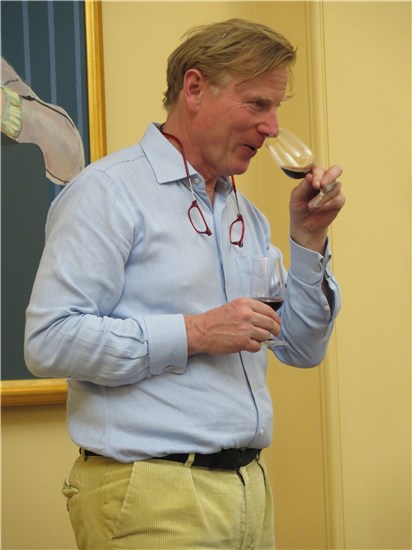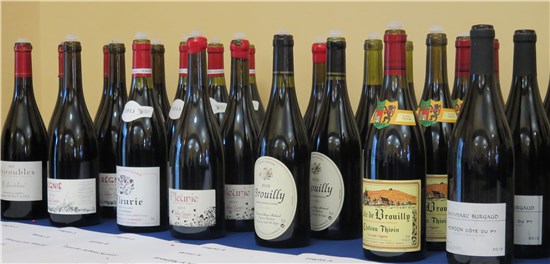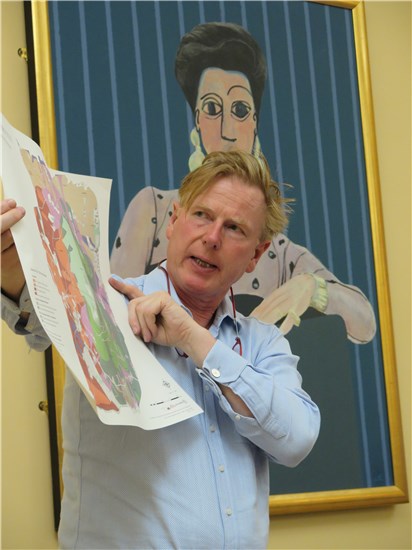 After possibly our most rapid AGM ever, the real business of wine tasting got underway. Jasper is BBRs’ Burgundy expert and Beaujolais effectively falls within the remit. Beaujolais also happens to be something that Jasper is very keen on. In fact it is one of his regular drinking wines for home and his cellar has a very ample selection of wines, many with some significant age.
After possibly our most rapid AGM ever, the real business of wine tasting got underway. Jasper is BBRs’ Burgundy expert and Beaujolais effectively falls within the remit. Beaujolais also happens to be something that Jasper is very keen on. In fact it is one of his regular drinking wines for home and his cellar has a very ample selection of wines, many with some significant age.
Aged Beaujolais at first sight seems to be something of an anachronism. However what we are looking at today is the village Crus, and not the Beaujolais Nouveau or even the Beaujolais Village that many will remember from the past. And these wines are indeed something quite different as we were all about to find out.
Jasper isn’t a fan of Nouveau, in fact despite its early success in countries such as the UK and Japan he feels that this has significantly damaged the reputation of the region and has left producers with low prices for some exceptional wines. Nouveau has undergone a number of incidents in its past which mostly fall around loss of market share being compounded by the producers making worse wine to try to make a profit – illegal chaptalisation, breaking of volume quotas, and blending of poor quality wines to bulk out better ones were all seen in the 2000’s. However Beaujolais offers some real gems, something you’d not expect and after this tasting are likely to want to drink again!
The Cru villages are separate appellations and have unique soils structures and terroir. It’s not simple granite schist as you are often led to believe – many are based around volcanoes and have a lot of volcanic matter in the soils. A range of growing conditions, the best aspects being south and east facing slopes, along with varying altitude all lead to each Cru offering a different experience for the drinker. Producers can choose from trellising or bush vines and many of the vines themselves exceed 50 years old, so output is actually quite low and the fruit concentrated. The lighter wines are from areas such as Chiroubles and Regnie all the way up to more robust tannic wines from Morgon and Moulin-a-Vent. In all cases the alcohol content is a reasonable 12% - 13% and thus offer a lower alcohol alternative. They are all good with food and can be drunk slightly chilled.
 For this tasting we had the benefit of a selection of wines from 2012, 13 and 14. Some of these were considered too young to show at full potential. Even in the Crus the wine still undergoes a semi-carbonic maceration, but unlike the Nouveau these wines are left to macerate for a longer period of time and thus extract more phenolics and tannins. “A Beaujolais with tannin?!” I hear you cry. Well some of the wines are showing some firm but well integrated tannin structure and are a world away for the Beaujolais you may remember. In addition, due to a number of new producers or some producers moving into Beaujolais from Burgundy, many wines are now made in the Burgundian style and undergo maturation in small oak barrels, although most barrels are not new and are used to manage a slow oxidative maturation before bottling rather than the producer seeking significant oak for the wines.
For this tasting we had the benefit of a selection of wines from 2012, 13 and 14. Some of these were considered too young to show at full potential. Even in the Crus the wine still undergoes a semi-carbonic maceration, but unlike the Nouveau these wines are left to macerate for a longer period of time and thus extract more phenolics and tannins. “A Beaujolais with tannin?!” I hear you cry. Well some of the wines are showing some firm but well integrated tannin structure and are a world away for the Beaujolais you may remember. In addition, due to a number of new producers or some producers moving into Beaujolais from Burgundy, many wines are now made in the Burgundian style and undergo maturation in small oak barrels, although most barrels are not new and are used to manage a slow oxidative maturation before bottling rather than the producer seeking significant oak for the wines.
The classic pallet of Beaujolais will be remembered by many as “bubble-gum” with strawberry and banana. A product of the carbonic maceration process rather than being dominated by the grape. There are no tannins and the wines are made for quick drinking. Other than a delicate hint of bubble-gum on the first wine of the evening, the rest of the wines are quite unlike your preconceptions and the quality and balance were there to see in all. Interesting as we made our way through the Crus, with a highly engaging and informative commentary by Jasper, we discovered that in general people preferred the heavier and more tannic wines. Pricing was not a major factor as all the wines fell between £13 and £23 and pricing was varied within each region.
 In fact what we did discover is that the terroir and winemaking process has a significant impact on the wines and as you move from the lighter expressions through to the more robust wines you find that vinication drives more of the finished product than the grape varietal. The Beaujolais Crus simply offer such a wide variety of choice from a single grape variety that there really is something here for everyone.
In fact what we did discover is that the terroir and winemaking process has a significant impact on the wines and as you move from the lighter expressions through to the more robust wines you find that vinication drives more of the finished product than the grape varietal. The Beaujolais Crus simply offer such a wide variety of choice from a single grape variety that there really is something here for everyone.
Vintage also has a major impact. Some of the more robust wines from Morgon and Moulin-a-Vent can easily age for a decade or more, the lighter wines less so. 2012, 13 and 14 are all offering great drinking now and many will continue to do so. It’s certainly well worth putting a few in the cellar and see how they develop. 2014 was a particularly good year. 2015 had some exceptional wines but was a “big” year and some of the heavier wines are dominated by tannin and alcohol. Only time will tell if these develop into more approachable wines.
The Club had a great night, being guided through the terroir, history and wines of the Beaujolais Crus by the always engaging and knowledgeable Jasper. Many thanks to him for putting on such an excellent event for us.
Below are the wines we tasted. My personal favourites were Fleurie Domaine Julien Sunier, the Brouilly Alain Michaud, the Morgon Cote du Py Jean Marc Burgaud and the Moulin-a-Vent Les Rochaux. I will likely be taking up the offer on some of these!
Philip Spinks, May 2016
|
1
|
Chiroubles - La Scandaleuse, Bernard Metrat 2014
|
|
2
|
Regnie - Domaine Julien Sunier 2014
|
|
3
|
Fleurie - Les Moriers, Domaine Cedric Chignard 2013
|
|
4
|
Fleurie - Domaine Julien Sunier 2013
|
|
5
|
Brouilly - Alain Michaud 2013
|
|
6
|
Cote de Brouilly - Les Sept Vignes, Chateau Thivin 2013
|
|
7
|
Morgon - Côte du Py, Jean Marc Burgaud 2013
|
|
8
|
Morgon - Javernières, Domaine Louis Claude Desvignes 2013
|
|
9
|
Moulin-à-Vent - La Rochelle, Olivier Merlin 2012
|
|
10
|
Moulin-à-Vent - Les Rochaux, Thibault Liger-Belair 2012
|